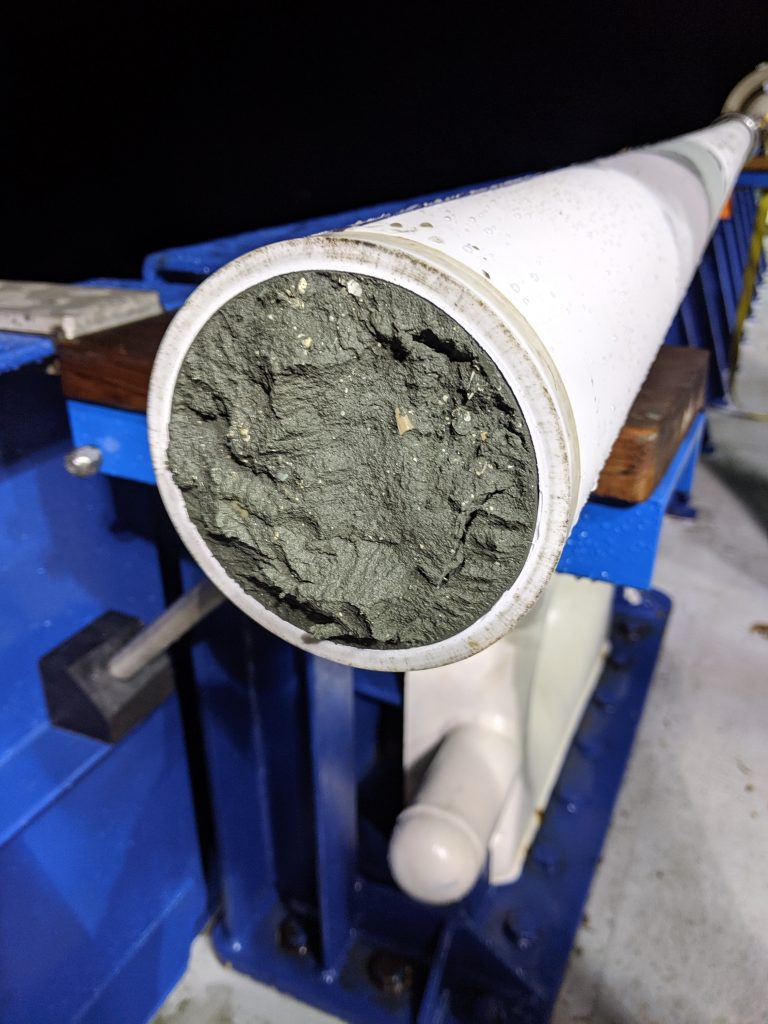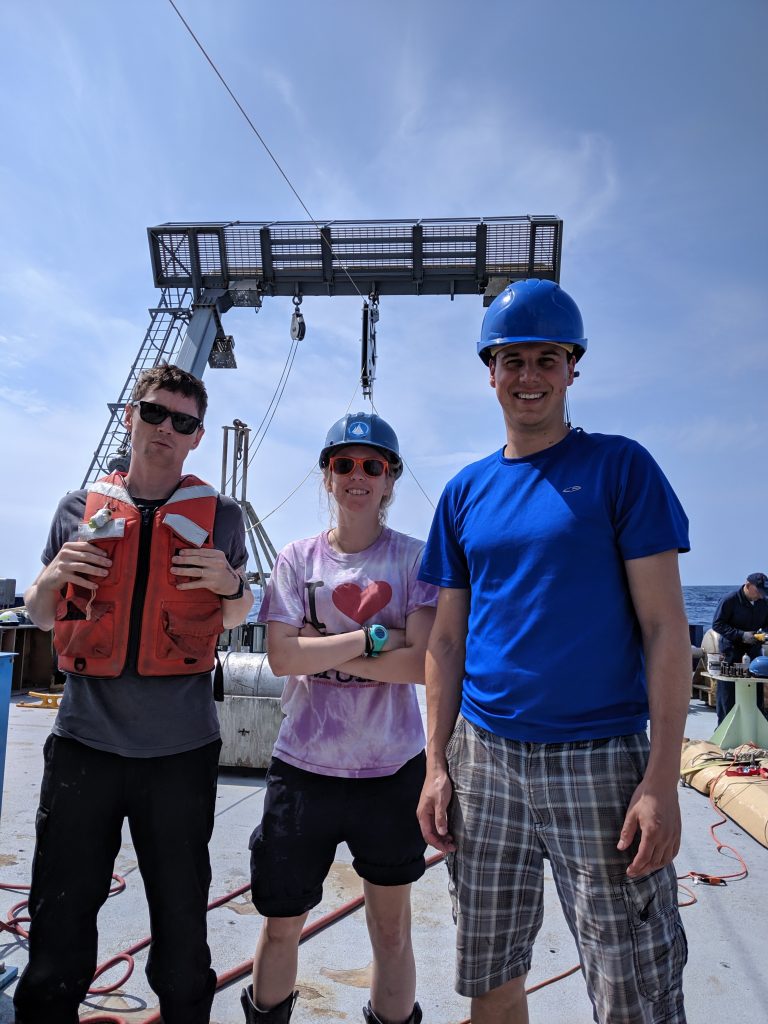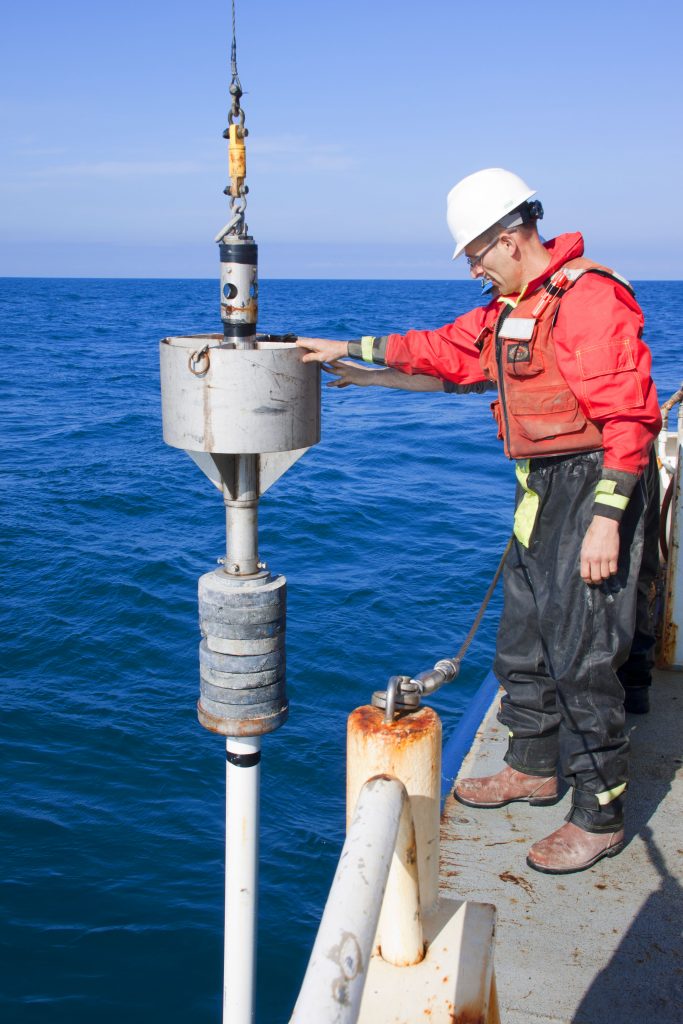Can we use mud to understand climate change?
Professor David Thornalley from University College London, in the UK, has been using data from ocean floor mud to understand how the Atlantic Ocean has changed over thousands of years into the past and how it may change in the future due to climate change. His data show that the ocean’s circulation has been weakening, probably as a result of human-caused warming
TALK LIKE A CLIMATE SCIENTIST
ATLANTIC MERIDIONAL OVERTURNING CIRCULATION (AMOC) – a system of water travelling from the tropics to the North Atlantic and back again
CLIMATE CHANGE – shifts in temperature and weather over a long time
GLOBAL TEMPERATURE – the average temperature around the world
PRECIPITATION PATTERNS – where and when rain, hail and snow is falling
CLIMATE MODEL – a computer programme that simulates how the Earth’s climate system – including the atmosphere and oceans – behaves
MARINE ECOSYSTEMS – ocean habitats and the creatures that live there
CENTENNIAL VARIABILITY – how something has changed over a 100-year or more period
Oceans are a key part of the Earth’s climate system, responsible for transporting heat and storing carbon from the atmosphere, and several large ocean current systems contribute to this. The Atlantic Meridional Overturning Circulation (AMOC) is a system of ocean currents in the North Atlantic, with a large influence on climate in the Northern Hemisphere. In his research project, ReconAMOC (Reconstructing the AMOC), Professor David Thornalley of University College London has been studying the AMOC using samples of ocean floor mud to understand how this system has varied in the past and how it may be affected by climate change in the future.
WHY IS THE AMOC SO IMPORTANT?
The AMOC is a system of ocean currents which includes warm water in the tropics flowing into the North Atlantic. The warm climate of the tropics means water evaporates from the ocean and it becomes salty. This salty water travels further north in the North Atlantic, where the climate is colder, and so the salty tropical water now also cools down. The cooler, saltier water sinks, and the dense water then flows southwards, before it eventually rises back to the surface in the Southern Ocean and also the tropical oceans. This creates a conveyer-like system.
Along with the water, large amounts of heat are transported around the Atlantic by the AMOC – David describes the amount as “equivalent to a thousand billion kettles boiling!” This is partly responsible for Europe having a warm climate, as the AMOC transports up to 25% of the Northern Hemisphere’s atmospheric and oceanic heat. Furthermore, CO2 is absorbed into the ocean as cool water sinks – the CO2 is stored in the deep ocean, so the cycle works to soak up some of the CO2 in the atmosphere.
WHAT IS AFFECTING THE STRENGTH AND STABILITY OF THE AMOC?
The driving force behind the AMOC’s centennial variability is thought to be the continuous formation of salty, cold, dense water in the North Atlantic. If the water becomes too warm – or has become less salty due to melting ice/changing precipitation patterns – the circulation will weaken and could become unstable. Because climate change is causing increased global temperatures, David expects the AMOC to be weakening, and that this will continue.
HOW CAN CLIMATE MODELS HELP US?
“Climate models are our best tools for investigating how climate may behave in the future,” explains David. “They are thought to be quite robust in simulating certain features of the climate system, such as the global temperature response to greenhouse gas increases.” However, many important ocean processes take place on a very small scale, and many older climate models can only simulate large (100 km square) areas. It is also sometimes difficult to improve the models because we do not have as much real-world data to compare them to as we would like. “This can lead to the modelled ocean behaving in ways that may not be the same as the real ocean,” says David. “One way around this is to simply try and prescribe larger scale behaviour based on set equations, but we need to know we are doing this in an accurate way.” Lots of time and effort is continually being spent trying to improve climate models, and newer models are now much better at resolving – or simulating – processes on smaller areas. As David says, “With improved computer power and scientific understanding, it is an exciting and optimistic time for research.”
WHAT NOVEL APPROACH IS RECONAMOC TAKING?
David’s project uses marine sediment cores – samples of mud from the ocean floor – to create a dataset representing the North Atlantic over the past 7,000 years. “Our project is ambitious because, in some locations, we are trying to reconstruct the AMOC over a thousand years or more,” says David. “This means we are having to undertake thousands of analyses!”
David’s team travels by ship to sites around the North Atlantic and lowers metal pipes into the soft mud. When the pipe containing marine sediment is pulled back up, the team can observe the layers in the sample and analyse their contents. Currently, there are no direct observations longer than a few decades, so ReconAMOC is a big step forward. David’s team compares the mud from past years to recent conditions, to make sure that the data does a good job of representing the AMOC.
WHAT IS THE PROCESS OF ANALYSING DEEP-SEA MUD?
David says examining the layers in the mud is “like reading the pages in a book”, with the process telling the ‘narrative’ of how the ocean behaved in the past. The analysis can reveal the speed of past water currents, as larger grains in the mud indicates how currents have varied in the past. David’s team also looks at the types of shells in the sample – different marine species like to live in different conditions, so by looking at what shells are present, the team can ascertain what marine ecosystems existed in the past.
David’s analysis has shown what he describes as the “recent weakening of the AMOC, that is unprecedented in at least 1,600 years”. This weakening is probably tied to human-caused climate change because of increasing global temperature. New data suggests the changes David is seeing have not been observed for up to the past 10,000 years.
WHAT SUCCESSES HAS RECONAMOC HAD, SO FAR?
David and his team have been really pleased with how much data they have been able to generate. Their work has been written about in the New York Times in the US and The Guardian newspaper in the UK and has been used to help write Intergovernmental Panel on Climate Change (IPCC) reports and produce policy briefings for governments. All of this is contributing towards people becoming more aware of the AMOC and how climate change is affecting the oceans.
WHAT IS NEXT?
As well as ensuring others know about their current findings, David and his team are determined to further their research and gain even deeper insights. “We want to better understand the precise mechanisms that caused these recent changes,” he says. “We want to know how much was due to human-induced warming, versus natural processes. We are also trying to find out how these changes in the AMOC affected life in the ocean, to help ensure we can conserve marine ecosystems and use marine resources in a sustainable way.”
The more we understand how the AMOC has varied in the past, the better we can understand the impact that modern day climate change is having on our oceans. Understanding climate change is key for planning and preparing for its impact, and climate scientists like David are at the forefront of this important work.
 PROFESSOR DAVID THORNALLEY
PROFESSOR DAVID THORNALLEY
Professor of Ocean and Climate Science, University College London, UK
FIELD OF RESEARCH: Ocean and Climate Science
RESEARCH PROJECT: Analysing data from ocean floor mud samples to understand how the Atlantic Meridional Overturning Circulation is changing
FUNDERS: Natural Environment Research Council (NERC), European Union Horizon 2020
Funding was provided by NERC Project ReconAMOC (NE/S009736/1). This project has received funding from the European Union’s Horizon 2020 research and innovation programme under grant agreement No’s 678760 (ATLAS) and 818123 (iAtlantic). This output reflects only the authors’ views and the European Union cannot be held responsible for any use that may be made of the information contained therein.
ABOUT CLIMATE SCIENCE
Climate science is a wide-ranging subject that studies the impact of climate change on all parts of the Earth. This may be focused on the oceans (as David’s work is) but can also be focused on the atmosphere, how ice sheets are changing and how human impact is affecting ecosystems.
The oceans are a key part of the climate system. David describes how the world’s ocean has taken up about 50% of the historical emissions of carbon dioxide released by humans. It is very important, therefore, to understand how oceans are behaving and changing in response to climate change.
A key aspect of climate science is making sure that the true impact of human-caused warming is understood. David says, “We want to better understand the precise mechanisms causing these recent changes, and how much was due to human induced warming, versus other natural processes.” This is important to make sure the impact that humans are having on the planet is clear and undeniable.
WHAT ARE THE RESPONSIBILITIES OF BEING A PRINCIPAL INVESTIGATOR ON A PROJECT LIKE THIS?
As principal investigator (PI), David helps the team to interpret the new data, coming up with new ideas about how the oceans have behaved. He is responsible for overseeing the technicians who work in the labs and has meetings with his team to make sure everyone is comfortable with what they are doing and keeping on track. His responsibilities also include keeping an eye on budget and timelines, as well as meetings with scientists from other universities working in the same field.
WHAT ARE THE REWARDS?
David enjoys being at the cutting edge of science, finding something unique and unexpected during his research. He says, “It’s really cool at that moment in time to be the first (or one of the first people) to know a particular fact, and then thinking about how it changes your view of the world and how it works.” Being part of a team is also a rewarding and exciting aspect of his work – being able to work together to contribute towards understanding the climate crisis is hugely important and motivating.
EXPLORE CAREERS IN CLIMATE SCIENCE
• The continuing threat of climate change means that climate scientists are needed now more than ever. You could work for a university or a climate change charity and find yourself taking part in field work all over the world where climate impacts are being felt, from the North Atlantic to Antarctic glaciers to tropical rainforests.
• To keep up to date with climate science news, the Woods Hole Oceanographic Institute has updates about climate and ocean science.
• The Challenger Society also provides information.
• Look for volunteering opportunities with climate change charities in your local area.
• At university, you might find experience through a summer internship, such as with the Natural Environment Research Council or University College London.
Reference
https://doi.org/10.33424/FUTURUM332
PATHWAY FROM SCHOOL TO CLIMATE SCIENCE
• Study maths and at least one science subject at A-level. These are likely the entry requirements for a climate science or related degree at university.
• David says, “Computer and coding skills are becoming more and more important and offer another way into the field.” You can get computing experience at school or through online courses.
• Many universities offer degrees in Earth or ocean sciences. You can also start with a degree in physics, chemistry, biology or maths, and then specialise in climate or ocean sciences for a postgraduate degree.
HOW DID DAVID BECOME A CLIMATE SCIENTIST?
WHAT INSPIRED YOU TO BECOME A SCIENTIST?
I enjoyed reading science books as a kid and watching David Attenborough documentaries. I loved reading about famous physicists and their discoveries, but I also wanted to work with wildlife and thought about being a zookeeper or observing wildlife in the field for conservation. I guess I always just loved watching the world and trying to find out how things worked.
WHAT ATTRIBUTES HAVE MADE YOU SUCCESSFUL AS A SCIENTIST?
I have quite a good memory for things I read, which helps me to remember key ideas and evidence. I was always willing to work hard on simple mundane tasks (lots of swimming sessions get you used to monotony!), which helped me to produce datasets during my earlier research years. I’m driven to find answers – I love when you have new data and you are on the hunt to try and make sense of it, and then when it finally clicks, it is really rewarding and exciting. I think I am openminded as well, which helps you to reject established ideas if they don’t make sense, or to try and think up new ones.
HOW DO YOU SWITCH OFF FROM YOUR WORK?
The commute home on the train, reading a non-science book and having a 5-year-old son to feed and get ready for bed all help!
AS A CLIMATE SCIENTIST, HOW DO YOU REMAIN OPTIMISTIC AND MOTIVATED?
I feel guilty saying it, but my main motivation has always been finding out about the world and solving puzzles; it is just nice that the work I do is also in an area that is important and, hopefully, useful to society. Scientists play a vital role in helping us to know how the world might change, so we can plan and prepare, but lots of different people need to work together – we have the evidence, but the solutions also involve politics and social science.
WHAT ARE YOUR PROUDEST CAREER ACHIEVEMENTS, SO FAR?
I collected some data during my PhD and for months and months (I think maybe a year) I couldn’t work out how to interpret it and then, after doing loads of reading, it all finally clicked. That idea went on to be my first paper and I was lucky enough to get it published in Nature.
WHAT ARE YOUR AMBITIONS FOR THE FUTURE?
I hope I can really help my PhD students and others in the team achieve their goals and make some of our students see how cool studying the ocean is. For now, I’d be happy to find time to write up all the exciting results we have been getting from ReconAMOC, since some of the data we have is quite important for understanding how the world has been and is changing.
DAVID’S TOP TIPS
01 Find what you are interested in – work is easier when you are working towards something you are passionate about.
02 Be willing to work hard; there are times when you might have to spend hours doing something quite tedious.
03 Be inquisitive, start reading and then follow up on things you find interesting.
Do you have a question for David?
Write it in the comments box below and David will get back to you. (Remember, researchers are very busy people, so you may have to wait a few days.)








